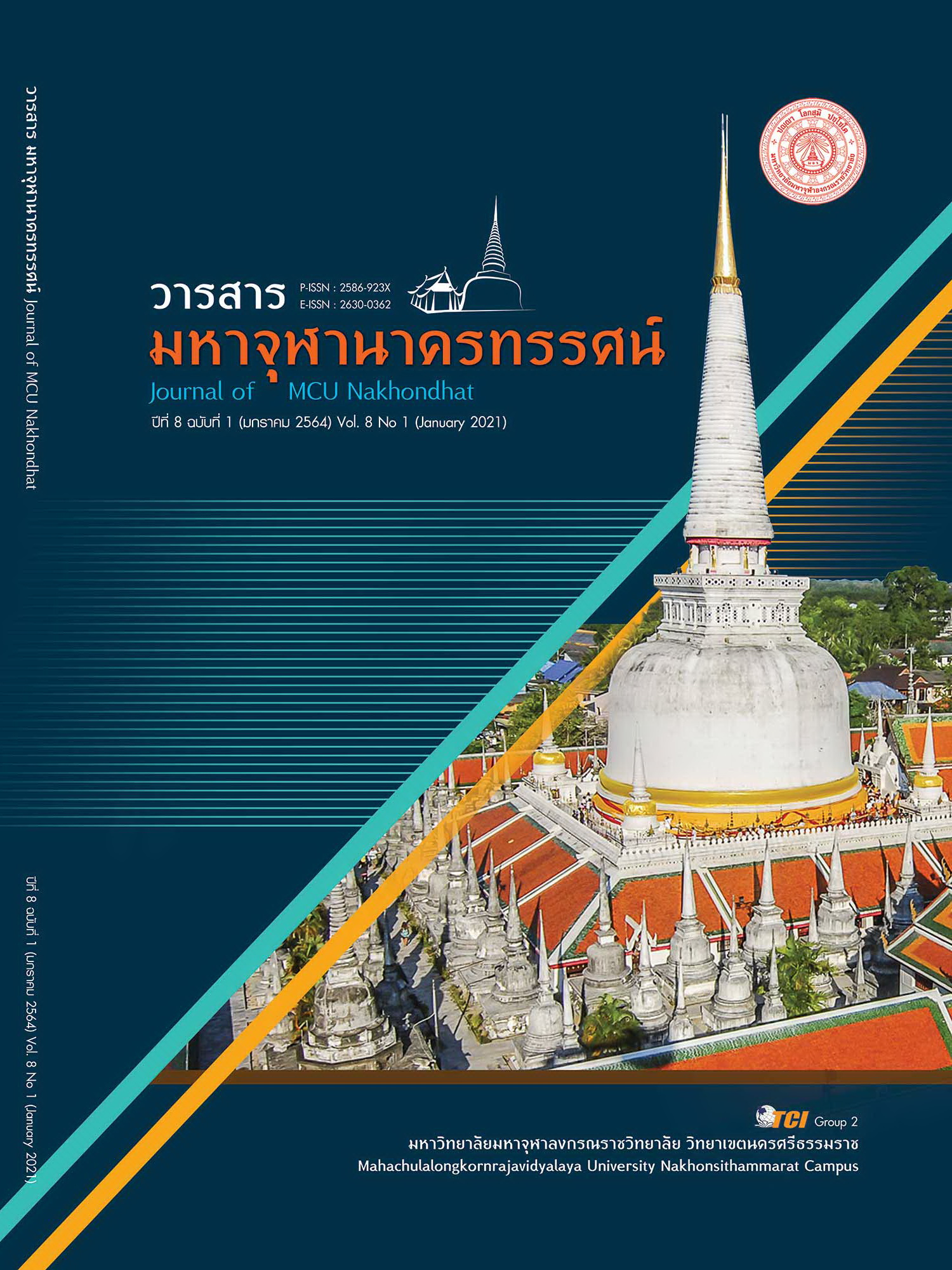FACTORS PREDICTING QUALITY OF LIFE IN CHRONIC NCDS CLINIC HUASAI HOSPITAL, HUASAI DISTRICT, NAKHON SI THAMMARAT PROVINCE
Main Article Content
Abstract
The objective of this research was to study of quality of life level and determine the predictive of quality of life of elderly in chronic NCDs clinic Hua Sai Hospital, Hua Sai District, Nakhon Si Thammarat Province. The samples were 321 patients, aged 60 years and over who were treated in chronic NCDs clinic. Huasai Hospital, Hua Sai District, Nakhon Si Thammarat Province. They were selected by using the formula of Krejcie & Morgan. The research questionnaire consisted of 1) General data questionnaire, namely personal data, health condition and health care, 2) Thai Geriatric Depression Scale: TGDS, which the alpha Cronbach coefficient = 0.87 and 3) Quality of Life Assessment, that using Hamtanon, P. et al (2020) quality of life assessment, alpha Cronbach coefficient = 0.88. Data were collected from December, 2020 to January, 202. Data were analyzed using frequency, Percentage, Mean, standard Deviation and stepwise multiple regression analysis. The results showed that 1) the overall quality of life level of most of the elderly subjects had good quality of life and 2) predictive factors of quality of life of the elderly in chronic non - communicable disease clinic were depression, good health, primary education, secondary education, frequent participation in social activities and age, which all factors could predict quality of life with 31.60% (R2 = .316, p <.001).
Article Details
References
จุฬาลักษณ์ บารมี. (2551). สถิติเพื่อการวิจัยทางสุขภาพและการวิเคราะห์ข้อมูลด้วยโปรแกรม SPSS. ชลบุรี: ศรีศิลปการพิมพ์.
ปิยะวัฒน์ ตรีวิทยา. (2559). กรอบแนวคิดเกี่ยวกับคุณภาพชีวิต. วารสารเทคนิคการแพทย์เชียงใหม่, 49(2), 171-184.
ภาวดี เหมทานนท์ และคณะ. (2563). ความสัมพันธ์ระหว่างความภาคภูมิใจในตนเองและคุณภาพชีวิตของผู้สูงอายุที่มีโรคไม่ติดต่อเรื้อรัง. วารสารมหาจุฬานาครทรรศน์, 7(12), 1-14.
มูลนิธิสถาบันวิจัยและพัฒนาผู้สูงอายุไทย (มส.ผส.). (2563). สถานการณ์ผู้สูงอายุไทย พ.ศ. 2562. นครปฐม: สถาบันวิจัยประชากรและสังคม มหาวิทยาลัยมหิดล.
อณัศยา ซื่อตรง และทัศนา ชูวรรธนะปกรณ์. (2559). ปัจจัยทํานายคุณภาพชีวิตของผู้สูงอายุที่มีภาวะหัวใจล้มเหลว. วารสารพยาบาลโรคหัวใจและทรวงอก, 27(2), 58-70.
อัญชลี อังศธรรมรัตน์ และสมใจ รัตนศรีทอง. (2561). ปัจจัยที่สัมพันธ์กับความสำเร็จในการดูแลผู้ป่วยสูงวัย ที่เข้ารับการรักษาโรคเรื้อรังซับซ้อนที่ศูนย์ชีวนันท์โรงพยาบาลสวรรค์ประชารักษ์. ศรีนครินทร์เวชสาร, 33(5), 398-403.
อารดา ธีระเกียรติกำจร. (2554). คุณภาพชีวิตของผู้สูงอายุในเขตเทศบาล ตำบลสุเทพ อำเภอเมือง จังหวัดเชียงใหม่. ใน วิทยานิพนธ์เศรษฐศาสตรมหาบัณฑิต สาขาวิชาเศรษฐศาสตร์. มหาวิทยาลัยเชียงใหม่.
อุทัย สุดสุข และคณะ. (2552). โครงการศึกษาสถานการณ์ความสามารถในการปฏิบัติกิจวัตรประจำวันความต้องการ และคุณภาพชีวิตของผู้สูงอายุ. ใน รายงานการวิจัย. สมาคมคลังปัญญาอาวุโสแห่งประเทศไทย.
Chen, H. M. & Chen, C. M. (2017). Factor Associated with Quality of Life among Older Adults with Chronic Disease in Taiwan. International Journal of Gerontology, 11(1), 12-15.
Krejcie, R. V. & Morgan, D. W. (1970). Determining Sample Size for Research Activities. Educational and Psychological Measurement, 30(3), 607-610.
Lu, C. et al. (2017). Depression and Resilience Mediates the Effect of Family Function on Quality of Life of the Elderly. Archives of Gerontology and Geriatrics, 71(July 2017), 34-42.
Rodrigues, L. R. et al. (2017). Quality of Life of Elderly People of the Community and Associated Factors. Journal of Nursing, 11(3), 1430-1438.
Veni, R. K. & Merlene, A. M. (2017). Gender Differences in Self-esteem and Quality of Lifeamong the Elderly. Indian Journal of Health and Well-being, 8(8), 885-887.
World Health Organization. (2006). whoqol-old manual world health organization european office. Retrieved January 2, 2020, from https://www.who.int/mental_health/evidence/WHOQOL_OLD_Manual.pdf?ua=1

